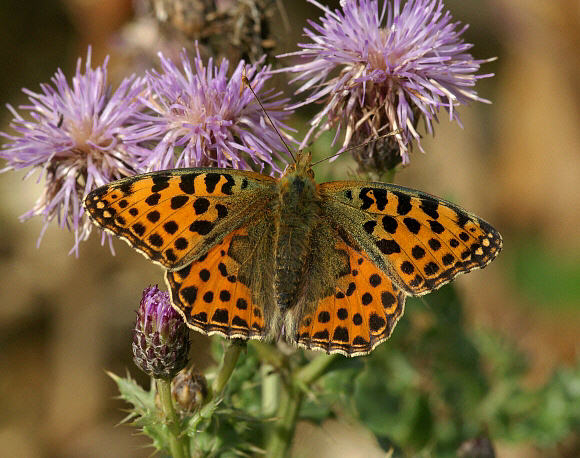
Queen of Spain Fritillary, female nectaring at thistle – Adrian Hoskins
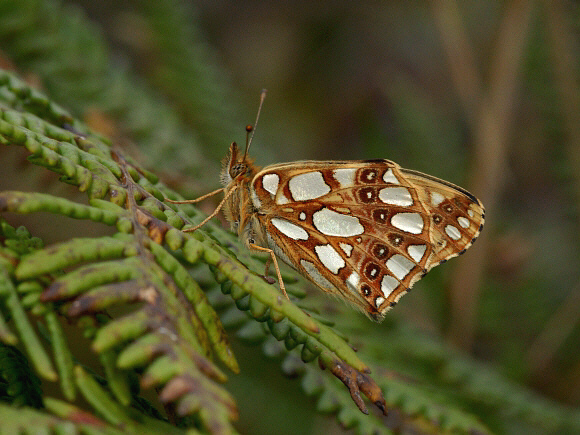
Queen of Spain Fritillary, female – Adrian Hoskins
Introduction
The Queen of Spain Fritillary is a fairly common butterfly in Europe and temperate Asia, but it only occurs in Britain as an extremely rare migrant, in fact there have been less than 400 records of this species since it was first recorded 300 years ago by William Vernon at Gamlingay, Cambridgeshire. The biggest migration was in 1872 when 50 were recorded in Britain, and in 1945, no less than 25 adults were recorded from Portreath in Cornwall, indicating that the butterfly had successfully bred there.
However there have been many years when not even a single specimen has been recorded anywhere in Britain, although there are possible indications that migrations may be increasing, most likely as a result of climate changes increasing the butterfly’s abundance in northern France.
An unusually high number of adults were recorded in 2007, when 6 were reported from various parts of Hampshire and Sussex. These migrations seem to originate from Normandy, and funnel into the UK via river valleys. Small migrations also took place in 2008 & 2009. In the latter case a single female arriving in West Sussex in July produced offspring which emerged in September and October – at least 7 different adults were recorded, including a mating pair on October 13th.
The very distinctive large silver spots on the underside hindwings mean that this butterfly is unlikely to be confused with any other species, although early summer specimens could possibly be mistaken in flight for a Pearl-bordered or Small Pearl-bordered Fritillary. In late summer or early autumn they could be confused in flight with a Wall Brown but the differences are obvious as soon as the butterfly settles.
Both sexes are very similar in appearance, although the female is slightly larger, with a shorter abdomen and a more greenish hue around the base of the upperside wings. The sexes can more easily be distinguished by their behaviour – females are sedentary, while males actively pursue all passing butterflies.
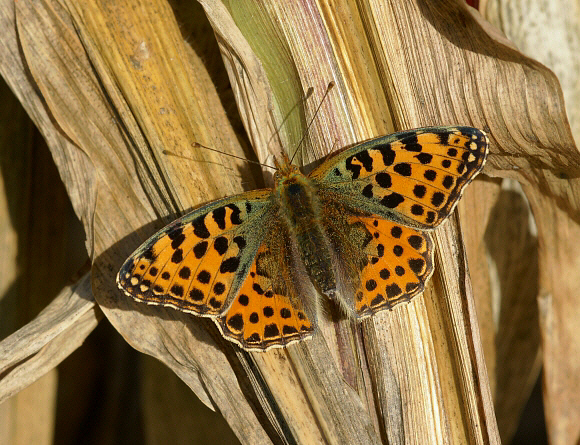
Queen of Spain Fritillary, female basking on maize – Adrian Hoskins
Habitats
This species breeds in a diverse range of habitats in Europe, ranging from hay meadows to heaths and woodlands. It tends to breed mainly in lowland areas but tends to migrate to higher altitudes particularly if the summer has been warm and dry, when it can be found up to an altitude of at least 2000m in the Alps and Pyrenees.
In Britain it requires warm dry habitats to breed successfully, but such events are extremely rare. In 2009 a female recorded on 14th July laid eggs at a farmland site in Sussex where the larval foodplant field pansy Viola arvensis grew around the margins of a maize crop. The progeny began to emerge in mid September and remained on the wing until mid October, with a maximum of 6 adults at the peak of the flight.
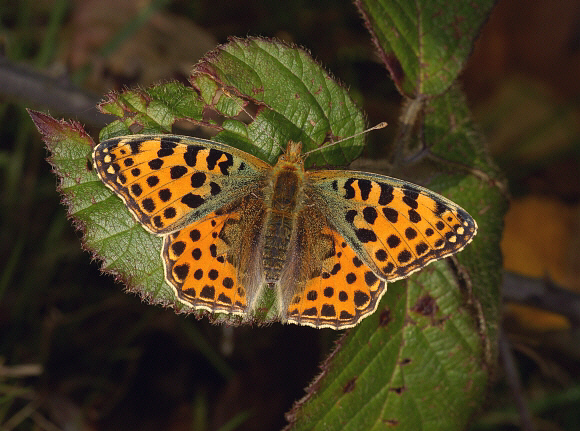
Queen of Spain Fritillary, basking on bramble – Adrian Hoskins
Queen of Spain Fritillary, basking on bramble – Adrian Hoskins
Lifecycle
In Europe there are 3 generations of this species, emerging in March/April, July, and September in lowland areas. In montane areas there is usually only a single brood which emerges in late June and remains on the wing until the end of August. Hibernation can occur in any stage of the lifecycle depending on location and climate, but most commonly occurs in the egg stage or as young larvae.
In Britain migrants usually arrive either in May or July, and if they breed here the progeny normally emerge in mid-late September. Eggs from the UK bred generation hatch after about a week.
The pale straw coloured eggs are conical in shape, with about 40 longitudinal keels. They are laid singly on the stems and leaves of the foodplants, and probably also on surrounding stems and leaf litter. Oviposition sites are invariably in dry sheltered situations where vegetation is sparse. Reportedly as many as 100 eggs can be laid by a single female per day in captivity.
The caterpillars are velvety black, heavily sprinkled with tiny white dots, and adorned with rows of dull orange spikes along the back and sides. They feed on field pansy Viola arvensis, wild pansy V. tricolor, and sweet violet V. odorata, but do not normally feed on other Viola species.
Prior to pupation the larvae wander aimlessly for 2 or 3 days without feeding, and eventually attach themselves by the tail to a button of silk spun on the underside of a leaf, or a low stem. The pupa, which wriggles frantically if disturbed, is blackish-olive colour, marked with small white patches on the abdomen, which is adorned with a series of stubby white spikes. It bears a strong resemblance to a bird dropping. The adult butterflies emerge in the morning, about 10-12 days after pupation.
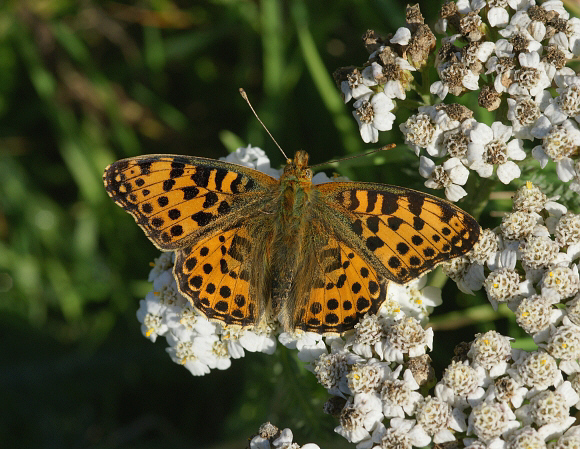
Queen of Spain Fritillary, male nectaring at yarrow – Adrian Hoskins
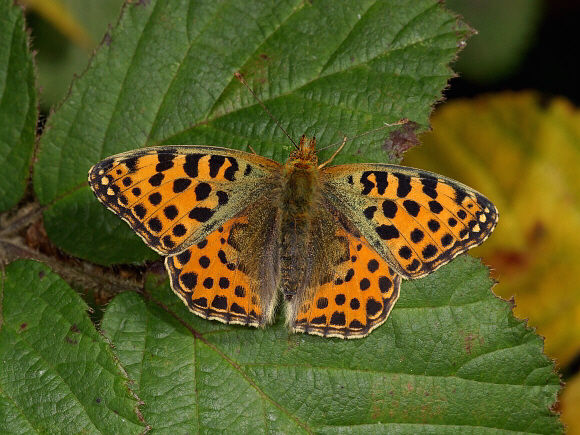
Queen of Spain Fritillary, female – Adrian Hoskins
Adult behaviour
Males tend to bask on flat dry paths, where they regulate their body temperature either by holding their wings in a “V”, or spread flat on the ground, depending on ambient conditions. They dart up to investigate passing butterflies, even those that could not possibly be mistaken for their own kind. In October 2009 for instance, at Chichester in Sussex, I witnessed a 3-way territorial “dog-fight” when a male dashed up from his perching place to intercept a pair of sparring male Clouded Yellows.
Both sexes visit a wide variety of flowers for nectar, including thistles, hawkbit, cow parsley, thyme, dandelion, hemp agrimony, marjoram, yarrow and bramble blossom. When nectaring the wings are normally held almost fully outspread. In the Alps and Pyrenees I have often seen males imbibing at the edge of puddles, and at these times the wings are normally held erect.
The adults are not particularly wary of humans, and tend to fly a short distance and resettle on the ground a few metres away if disturbed. They have a zigzag fluttery flight low over the ground, but males often fly over bushes, or soar up a slope, or over the edges of tall crops for a few moments before circling around and returning to a favoured warm sheltered spot.
Roosting probably takes place mainly in the tree tops – in Sussex e.g. where the species bred at the edge of a maize field in 2009, both sexes regularly roosted at the top of oaks and sweet chestnuts in late afternoon. At the same site however they were also found roosting among herbage and on thistles and knapweed flowerheads. I also watched 2 males go to roost on maize plants, where they settled hanging beneath broad dry leaves high up on the plant.
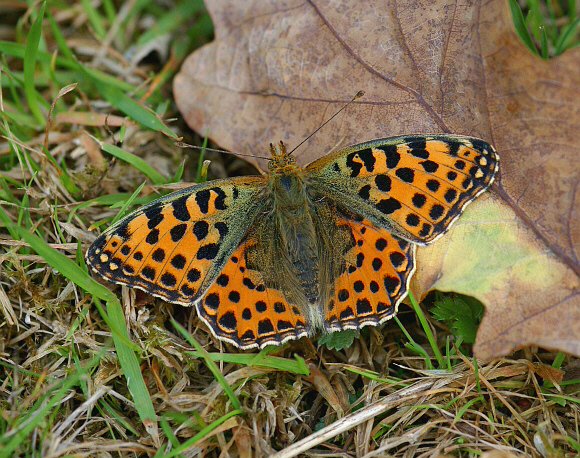
Queen of Spain Fritillary, female – Adrian Hoskins
